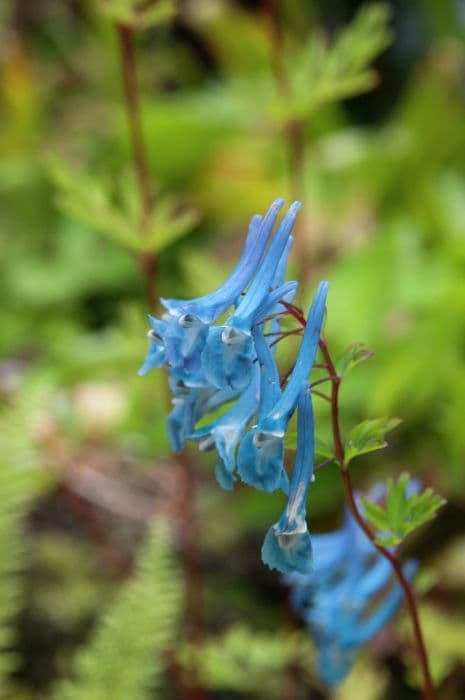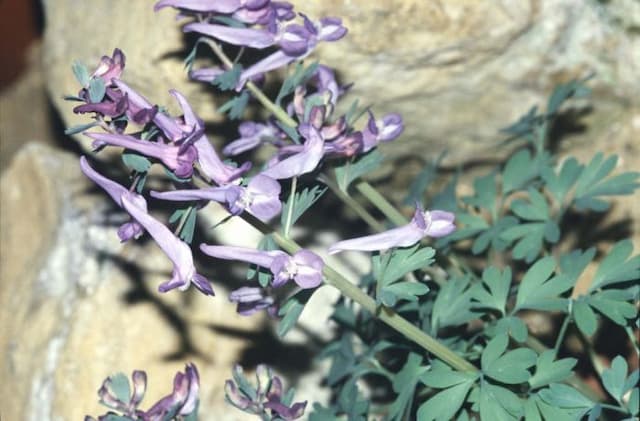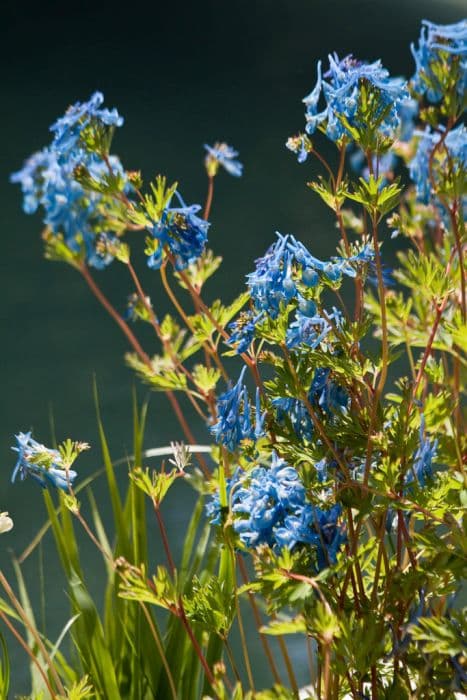Bleeding Heart Lamprocapnos spectabilis Valentine = 'Hordival' (PBR)

ABOUT
Commonly known as bleeding heart, Lamprocapnos spectabilis Valentine, with its trade name 'Hordival', is a charming perennial plant characterized by its striking appearance. Like other bleeding hearts, this variant distinguishes itself through its beautiful heart-shaped flowers. The flowers are an exquisite shade of deep red, resembling tiny, delicate hearts that dangle gracefully from arched stems. These stems arch over the plant's lush foliage. The foliage of the Valentine bleeding heart is no less attractive than its flowers. The leaves are a soft green color and are divided into segments, which gives them a fern-like appearance. As the seasons change, the foliage may take on a yellow hue, adding another layer of visual interest to this already captivating plant. Bleeding heart Valentine creates a whimsical presence in a garden, with its bloom time usually in the spring. The flowers tend to grow in a row on each stem, forming an elegant line of hearts that seem to dance with the slightest breeze. The contrast between the red flowers and the green foliage is particularly striking, and this plant often becomes the focal point of any area where it is planted, drawing the eyes of passersby and garden visitors alike. This plant is cherished not only for its ornamental value but also for its capacity to evoke a sense of romance and enchantment in the garden. Its distinctive flowers and graceful growth habit have made it a favorite among gardeners looking to add a touch of drama and color to their floral arrays.
About this plant
 Names
NamesSynonyms
Bleeding Heart, Valentine Bleeding Heart, Dutchman's Breeches.
Common names
Dicentra spectabilis 'Valentine', Diclytra spectabilis Valentine.
 Toxicity
ToxicityTo humans
The most common common name for Lamprocapnos spectabilis is Bleeding Heart. It is considered mildly toxic if ingested. The toxic components are isoquinoline alkaloids, which can cause symptoms such as dizziness, fainting, and skin irritation. If large quantities are ingested, it could potentially lead to more serious symptoms, but generally, the plant is not life-threatening to humans.
To pets
For pets, the Bleeding Heart plant is also toxic due to the presence of isoquinoline alkaloids. If pets ingest parts of the plant, they may experience symptoms such as drooling, nausea, vomiting, diarrhea, and convulsions. In severe cases, it might lead to breathing difficulties or heart problems. Pet owners should ensure that their animals avoid ingesting any parts of the Bleeding Heart plant.
 Characteristics
CharacteristicsLife cycle
Perennials
Foliage type
Deciduous
Color of leaves
Green
Flower color
Red
Height
2 feet (0.6 meters)
Spread
2 feet (0.6 meters)
Plant type
Herb
Hardiness zones
3-9
Native area
Eastern Asia
Benefits
 General Benefits
General Benefits- Aesthetic Appeal: The heart-shaped flowers and vivid red color of the Bleeding Heart 'Valentine' make it an attractive addition to any garden.
- Seasonal Interest: It provides a burst of color in spring, enhancing the garden's seasonal variety.
- Attracts Pollinators: Bees and butterflies are drawn to the flowers, aiding in the pollination of the garden.
- Easy to Grow: The plant is relatively easy to care for, requiring minimal maintenance once established.
- Shade Tolerance: It thrives in partial to full shade, making it ideal for garden spots that receive less sunlight.
- Drought Resistance: Once established, the Bleeding Heart 'Valentine' can tolerate periods of dryness.
- Deer Resistance: It is not a preferred food source for deer, reducing the likelihood of damage in areas with deer populations.
 Medical Properties
Medical PropertiesThis plant is not used for medical purposes.
 Air-purifying Qualities
Air-purifying QualitiesThis plant is not specifically known for air purifying qualities.
 Other Uses
Other Uses- Photography: Bleeding Heart's unique heart-shaped flowers make it an excellent subject for photographers, especially those focusing on botanic, macro, and fine art photography.
- Valentine's Day Gift: As the 'Valentine' variety suggests with its heart-shaped flowers and red color, it can be given as a living Valentine's Day gift that lasts longer than cut flowers.
- Educational Tool: Biology teachers can utilize Bleeding Heart to teach students about plant morphology and pollination strategies, as its distinct flower shape offers a clear view of its reproductive parts.
- Arts and Crafts: The flowers of the Bleeding Heart can be pressed and used in art projects, scrapbooking or making homemade greeting cards due to their distinctive and visually appealing shape.
- Dyed Flowers: For artistic or decorative purposes, the stems of the Bleeding Heart can be split and placed in different colored dyes to change the color of the white or pink flowers as a demonstration of capillary action in plants.
- Sensory Garden Plant: The Bleeding Heart can serve as a tactile plant in sensory gardens, with its soft foliage and unique flowers adding a textural element for visitors to touch and feel.
- Nature-inspired Design: Designers may use the shape of Bleeding Heart flowers as inspiration for patterns or motifs in textiles, jewelry, and other decorative arts.
- Living Fences: When planted in a row or in close proximity, Bleeding Heart plants can create a visually attractive “living fence” during their blooming season.
- Theme Gardens: Bleeding Heart makes a suitable plant for 'romantic' or 'fairytale' themed gardens due to its whimsical flower shape and its common association with love and affection.
- Garden Photography Backdrop: Tall, densely planted groups of Bleeding Heart can create a lush and romantic backdrop for garden photography, especially for springtime photo sessions such as engagements or weddings.
Interesting Facts
 Feng Shui
Feng ShuiThe Bleeding Heart is not used in Feng Shui practice.
 Zodiac Sign Compitability
Zodiac Sign CompitabilityThe Bleeding Heart is not used in astrology practice.
 Plant Symbolism
Plant Symbolism- Affection: Also known as Bleeding Heart, this plant's heart-shaped flowers are commonly associated with deep feelings of love and passion, symbolizing a strong affection for someone.
- Compassion and Empathy: The Bleeding Heart has come to represent compassion and empathy, as the heart often symbolizes emotion and its unique shape and droplets can signify a bleeding or aching heart in tune with the feelings of others.
- Expressive: With its dramatic appearance, the Bleeding Heart symbolizes the ability to freely express one's feelings, often in a romantic context.
- Rejected Love: The pendulous shape of the Bleeding Heart flowers can also symbolize sadness, often related to unrequited or rejected love.
- Grace and Elegance: Because of their delicate and unique appearance, Bleeding Heart flowers are often associated with grace and elegance in the plant world.
 Water
WaterFor the Bleeding Heart 'Valentine' variety (Lamprocapnos spectabilis 'Valentine'), water it thoroughly whenever the top inch of soil feels dry to the touch, which may be once a week depending on climate and soil conditions. It is crucial to avoid overwatering, as this can lead to root rot. Ideally, provide deep watering to encourage deeper root growth. During the active growing season in spring and summer, you might water approximately one gallon per plant every week, adjusting for rainfall and temperature conditions. Cut back on watering in the fall as the plant goes dormant and requires less moisture.
 Light
LightThe Bleeding Heart 'Valentine' prefers dappled shade or part shade conditions where it can be protected from the intense heat of the afternoon sun. An ideal spot would be under the canopy of a deciduous tree or on the north or east side of a building where it can receive morning or late afternoon light. Bright, indirect light is optimal for promoting flowering without causing stress or leaf scorch to the plant.
 Temperature
TemperatureBleeding Heart 'Valentine' thrives in temperatures between 55 and 75 degrees Fahrenheit, which are ideal for its growth. They can tolerate minimum temperatures down to 20 degrees Fahrenheit, but prolonged exposure to such cold will force them into dormancy. During the summer, they can survive maximum temperatures up to 85 degrees Fahrenheit, but they prefer cooler conditions and may go dormant during hot spells.
 Pruning
PruningThe Bleeding Heart 'Valentine' benefits from pruning to remove spent flowers and encourage additional blooming. After the first flush of blooms fades, cut back the flower stems to stimulate a second flowering period. Once the foliage yellows and dies back in late summer or fall, prune the plant to ground level to maintain tidiness. Pruning is usually only required once per season after flowering, or as needed for aesthetic purposes.
 Cleaning
CleaningAs needed
 Soil
SoilBleeding heart (Lamprocapnos spectabilis 'Valentine') thrives in well-draining, moist soil rich in organic matter. The ideal pH for this plant is slightly acidic to neutral, ranging from 6.0 to 7.0. A good soil mix for bleeding heart might include garden loam, peat moss, and perlite or coarse sand to improve drainage.
 Repotting
RepottingBleeding hearts typically do not need frequent repotting and may only require repotting every few years. Repot your Bleeding heart if you notice the soil is depleted or the roots are crowded. Repot in the spring, just before new growth starts.
 Humidity & Misting
Humidity & MistingBleeding hearts prefer moderate humidity levels but are quite adaptable to different humidity conditions in a garden setting. They do not have specific humidity needs and will generally thrive if the soil moisture is maintained without the need for additional humidity control.
 Suitable locations
Suitable locationsIndoor
Place in partial shade and keep soil moist.
Outdoor
Partial shade, moist soil, shelter from wind.
Hardiness zone
3-9 USDA.
 Life cycle
Life cycleThe plant commonly referred to as Bleeding Heart 'Valentine' emerges from dormancy in early spring with new shoots that quickly develop into fern-like, green foliage. Shortly afterwards, it starts producing distinctive heart-shaped flowers, which are deep red in color and dangle from arching stems, usually blooming in late spring to early summer. After the flowering period, if conditions such as temperature and moisture levels are favorable, the plant may produce small, green fruits which contain seeds. Following the fruiting stage, the Bleeding Heart 'Valentine' begins to yellow and die back midsummer as it enters a period of dormancy, preserving energy in its root system for the next season. The plant remains dormant through the fall and winter, with the roots surviving underground. In the next spring, the cycle begins anew with the regrowth of shoots from the surviving roots, continuing its perennial life cycle.
 Propogation
PropogationPropogation time
Spring
The Bleeding Heart 'Valentine' is typically propagated by division, a method that is best performed in late fall or early spring. During this time, the plant is either dormant or just beginning to grow, which minimizes stress on the plant. To propagate by division, carefully dig up the entire plant, making sure to keep a generous amount of soil around the roots. Gently separate the plant into smaller clumps, ensuring that each section has a portion of the root system and at least one growth bud. Replant the divisions at the same depth they were originally growing, and water them well to help establish the new plants. This popular method helps maintain the vigor of your garden and allows you to share this beautiful perennial with friends or expand its presence in your own garden spaces.









